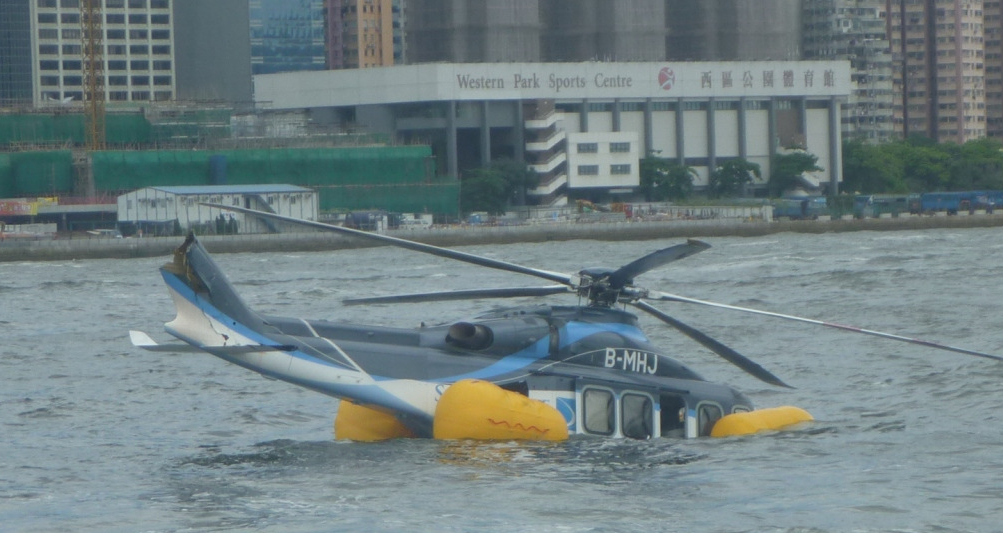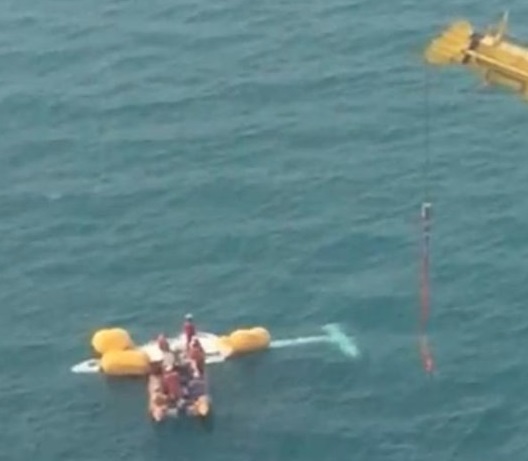Hong Kong Harbour AW139 Ditching – HKCAD Report Issued
The Hong Kong Civil Aviation Department (HKCAD) have issued their report into the ditching of AgustaWestland AW139, B-MHJ, operated by Macau based East Asia Airlines Limited (trading as SkyShuttle), in Hong Kong’s Victoria Harbour on 3 July 2010.
From the synopsis:
The helicopter took off from Sheung Wan / Sky Shuttle Heliport in Hong Kong at 0400 hrs (1200 hrs). Approximately 2 minutes after takeoff, shortly after the crew had completed the post-takeoff checks while climbing on a north-westerly heading at approximately 350 ft Above Mean Sea Level (AMSL) and at about 70 kt Indicated Airspeed (IAS), the tail rotor assembly detached from the helicopter. The commander immediately entered into autorotation and subsequently made a controlled ditching into the harbour. All pilots and passengers were rescued by the nearby vessels. Six of the 11 passengers received treatment for minor injuries.
The accident was notified to the Accidents Investigation Division of the Hong Kong Civil Aviation Department (CAD) by the Fire Services Communication Centre (FSCC) of the Fire Services Department (FSD) at 0405 hrs (1205 hrs) on 3 July 2010. The investigation team, comprising a team of CAD Inspectors of Accidents, started the investigation immediately. Two days later, investigators from the Civil Aviation Authority of Macao Special Administrative Region (AACM), Agenzia Nazionale per la Sicurezza del Volo of Italy (ANSV) and AgustaWestland (AW), the aircraft manufacturer joined the investigation team.
The investigation team has made two safety recommendations on the AW139 tail rotor blades.
They report the causal factors to be:
The failure of the White blade was most probably caused by disbond of pitch control arm and the reduction of torsion box stiffness at the blade root radii area, which when associated with manufacturing strap defects at maximum acceptable values in production specification, caused the ILRS to exceed the maximum allowable limit, resulting in matrix delamination onset and then propagation under ILSS and complete failure of the blade. ([Report paragraph] Reference: 3.1.2.2, 3.1.2.3, 3.1.2.4, 3.1.2.5, 3.1.2.6, 3.1.2.10, 3.1.2.11, 3.1.2.12)
The reduction in torsion box stiffness at the White blade root radii area was most probably caused by manufacturing quality lapses and the lack of effective way for checking the integrity of the torsion box after production. (Reference: 3.1.2.4, 3.1.2.8)
Disbond of the pitch control arm could have been caused by over shimming of elastomeric bearing installation. (Reference: 3.1.2.6)
Similar failures are believed to have occurred on the ground to AW139 A7-GHA of Gulf Helicopters in Qatar on 2 May 2011 and, fatally, offshore Brazil on 19 August 2011 (PR-SEK of Senior Taxi Aereo). Aerossurance understands that the report on the Brazilian accident is due to be published later this summer by the Brazilian accident investigation agency CENIPA (although a preliminary report is available online).

A7-GHA (Credit: Helihub)
The emergency flotation system of B-MHJ kept the helicopter afloat for 18 minutes and met the certification requirement of JAR 29.801(d), said CAD, who go on to comment:
Although the sea conditions were compatible with the certification of the equipment, the helicopter was significantly out of balance after ditching due to the loss of the tail rotor and the tail fin section and the ingress of water into the cabin through the opening left behind by the lost left-hand nose window transparency. The out of balance condition subsequently resulted in the overload and damage of the two forward floatation bags.
CAD, report that the failure was due to debonding and that improvements have since been made.
In the case of B-MHJ the Automatically Deployable Emergency Locator Transmitter (ADELT) deployed and transmitted successfully. ADELTs have not had a stunning service experience as the UK Civil Aviation Authority (CAA) recently reported in CAP1144. Ironically in this case the helicopter ditched in an area with an adjacent population of 3.3 million people (the combined populations of HK Island an Kowloon)!
The Macau aviation authority stated:
The Authority has reviewed the requirement of the helicopter life saving equipment. Two measures have been implemented as a result, namely revising the Air Navigation Regulation of Macau to mandate the equipage of life jackets and floatation system for helicopters taking off or landing at a heliport where the take-off or approach path is disposed over water, and reviewing the stowage method of the life jackets and then requesting the operator to improve the method.
The investigation also highlighted an unapproved modification to life jacket stowage pockets and the policy for radio setting.
The aircraft was not equipped with liferafts.
TV report from immediately after the recovery of the aircraft:
UPDATE 23 March 2016: EASA published NPA 2016-01 Helicopter ditching and water impact occupant survivability on a 3 month public consultation period.
Previous studies on and accident investigations into helicopter ditchings and water impact events have highlighted inadequacies in the existing certification specifications (CS-27, CS-29) and in the rules governing offshore operations. In particular, it has been established that in an otherwise survivable water impact, most fatalities occurred as a result of drowning because the occupants were unable either to rapidly escape from a capsized and flooded cabin, or to survive in the sea for sufficient time until rescue. Furthermore, the testing environment in which helicopters are type-certified for ditching bears little resemblance to the sea conditions experienced in operation.
In order to thoroughly address these and other ditching-related issues, and due to the nature of ditching-related hazards, this rulemaking task (RMT.0120 (27&29.008)) has taken a holistic approach to the problem, which crosses traditional airworthiness/operational boundaries. A detailed risk assessment has been undertaken that reflects both certification and operational experience and builds upon data extracted from accident reports and previous studies.
The specific objective of this NPA, however, is to propose changes to CS-27 and CS-29… Retroactive rules are to be considered in a second phase of this RMT.
…the primary change proposed aims to establish a new ditching certification methodology by which a target probability of capsize following a ditching can be determined based on the level of capsize mitigation applied to the design.
UPDATE 1 May 2017: Leonardo AW139 A6-AWN, operated by Abu Dhabi Aviation (ADA), made a precautionary ditching off the coast of the UAE: AW139 A6-AWN Ditching off UAE, 29 April 2017. All POB were rescued but the aircraft capsized before salvage.
UPDATE 12 June 2017: The GCAA Air Accident Investigation Section (AAIS) has issued their preliminary report into the A6-AWN ditching with commendable promptness (discussed further in our article AW139 A6-AWN Ditching off UAE, 29 April 2017).
UPDATE 9 February 2019: ADA AW139 A6-AWN Ditching off UAE, 29 April 2017: Final Report



Recent Comments